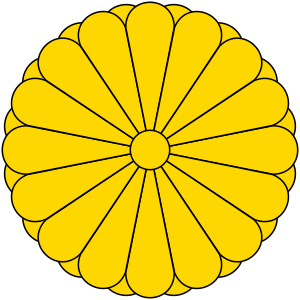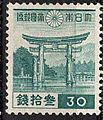Imperial Seal of Japan facts for kids
The Imperial Seal of Japan is a very special symbol used by the Emperor of Japan and his family. It is also known as the Chrysanthemum Seal (菊紋, kikumon) or Imperial chrysanthemum emblem (菊の御紋, kikunogomon). This is because it looks like a beautiful chrysanthemum flower. This seal is a type of mon, which is like a family badge or crest. It shows who belongs to the Japanese Imperial family.
Contents
What is the Imperial Seal?
The Imperial Seal is a unique design that represents the Emperor and the Imperial family of Japan. It is not just a pretty picture; it is a powerful symbol of their history and tradition. The seal has 16 petals on the front and 16 petals on the back, making a total of 32 petals. This specific design is very old and has been used for many centuries.
The Chrysanthemum Flower
The chrysanthemum flower is very important in Japan. It is not just any flower; it is a symbol of the Emperor and the Imperial family. The Japanese word for chrysanthemum is kiku. This flower represents long life, happiness, and royalty. It is so important that Japan even has a "Chrysanthemum Day" (Kiku no Sekku) in September. The Emperor's throne is sometimes called the "Chrysanthemum Throne." This shows how deeply connected the flower is to the Imperial family and the country itself.
A Symbol of Japan's Emperor
For a long time, the Imperial Seal has been the official emblem of the Emperor of Japan. It shows the Emperor's authority and his connection to the country's history. While Japan has a national flag, the Imperial Seal is a personal symbol of the Imperial family. It is used on many things that belong to or are connected with the Emperor. It reminds people of the long line of emperors who have ruled Japan.
Where You Can See It
You can find the Imperial Seal on many important items and places in Japan. For example, it is printed on the cover of Japanese passports. This shows that the passport belongs to a citizen of Japan, a country led by the Emperor. You can also see the seal on official documents, buildings related to the Imperial family, and even on some historical items like old coins or military flags. It is a way to mark things that are connected to the Emperor and the history of Japan.
Images for kids
-
Emblazoned on the doors of a tomb in Kyōtanabe, Kyoto
-
Bow of the battleship Mikasa
See also
 In Spanish: Emblema imperial de Japón para niños
In Spanish: Emblema imperial de Japón para niños







